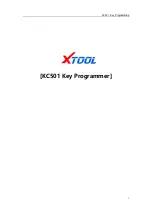
53
Serial Bus Analysis
Press the FILTER button in the TRIGGER section of the
control panel to list all available UART trigger conditions:
❙
START BIT:
Sets the start bit as trigger event. The start
bit is the first 0 bit that succeeds a stop bit or idle time.
❙
FRAME START:
Defines the first start bit after idle time.
❙
SYMBOL<N>:
Assigns a predefined N-th symbol as
trigger event.
❙
ANY SYMBOL:
The soft menu ANY SYMBOL allows you
to define any symbol to trigger on. The symbol can be
located anywhere within a frame. The serial bit sequence
(PATTERN INPUT) can be entered as binary or
hexadecimal value. If you choose the binary input, the soft
menu key SELECT BIT and the universal knob allow you to
select which individual bits within the data are to be
edited. Select the option STATE to assign a logic state to
each bit (High = H = 1, Low = L = 0 or X = don’t care).
The state X defines any state. If you choose the hexa-
decimal input, the soft menu key VALUE and the universal
knob allow you to set the value for the respective symbol.
If the input is hexadecimal, only the entire symbol can be
set to X. Use the soft menu key SELECT SYMBOL to
toggle between symbols.
❙
PATTERN:
Offers additional options for UART trigger
settings. The soft menu key SYMBOL OFFSET and the
universal knob are used to select the number of irrelevant
symbols that proceed the pattern within the frame that
are relevant for the trigger event. Any value between 0 to
4095 symbols after the start bit may be entered. Use the
soft menu key NUMB. OF SYMB. to select the number of
relevant symbols as 1, 2 or 3. The number of symbol
defines the pattern size. The symbol length (5 to 9 bit)
was configured at the time of the bus definition and will
be observed accordingly in the trigger menu. The value
input for the symbols may be binary or hexadecimal (as
described above). Use the soft menu key PATTERN
INPUT for this selection. If binary input is selected, the
individual bits can be assigned via soft menu key SELECT
BIT and the universal knob. The soft menu key STATE
allows you to determine the state for each bit (1, 0 or X).
If you choose the hexadecimal input, the soft menu key
VALUE and the universal knob allow you to set the value
for the respective symbol. Use the soft menu key SELECT
SYMBOL to toggle between symbols. The active byte will
Fig. 13.14: UART trigger menu page 2
be marked with a green border in the display window of
the trigger condition.
❙
PARITY ERROR:
Trigger with a parity filter
❙
FRAME ERROR:
Trigger with a frame error
❙
BREAK:
Trigger with a break. The BREAK condition is
fulfilled if a stop bit does not succeed a start bit within a
specified time
period. The stop bits low are active during
the break.
Press the MENU OFF button three times to close all
menus, and the oscilloscope will trigger on the set bit
sequence. For measurements without measuring object
please refer to chapter 10.2.5.
13 .6 .3 UART BUS Table
13 .7 CAN BUS
The CAN bus (Controller Area Network) is a bus system
primarily developed for automotive applications and is
used for the data exchange between controller units
and sensors. It can be found increasingly in the aviation,
healthcare, and general automation industries. At the
physical level, CAN is a differential signal, therefore a diffe-
rential probe (e.g. HZO40) is recommended for decoding,
although standard probes are equally suitable to capture
the signals. The standard data rates range between 10
kBit/s and 1 MBit/s. A CAN message primarily consists of
a start bit, the Frame ID (11 or 29 bit), the data length code
DLC, the data, a CRC, acknowledge and an end bit.
Fig. 13.15: Example UART BUS table
For CAN BUS trigger and decoding you need the R&S®HOO12
option or the upgrade voucher R&S®HV112.
Tab. 13.4: Content of the UART BUS table
Column
Description
Start Time
Time of frame start in relation to the trigger point
Data
Values of the data words
State
Frame State:
❙
OK
= Frame is valid
❙
DATA
= during acquisition start/end only te
frame start / frame end has been decoded;
currently no data available
❙
INS
= the frame is not completely contained in
the acquisition; the acquired part of the frame is
valid.
















































